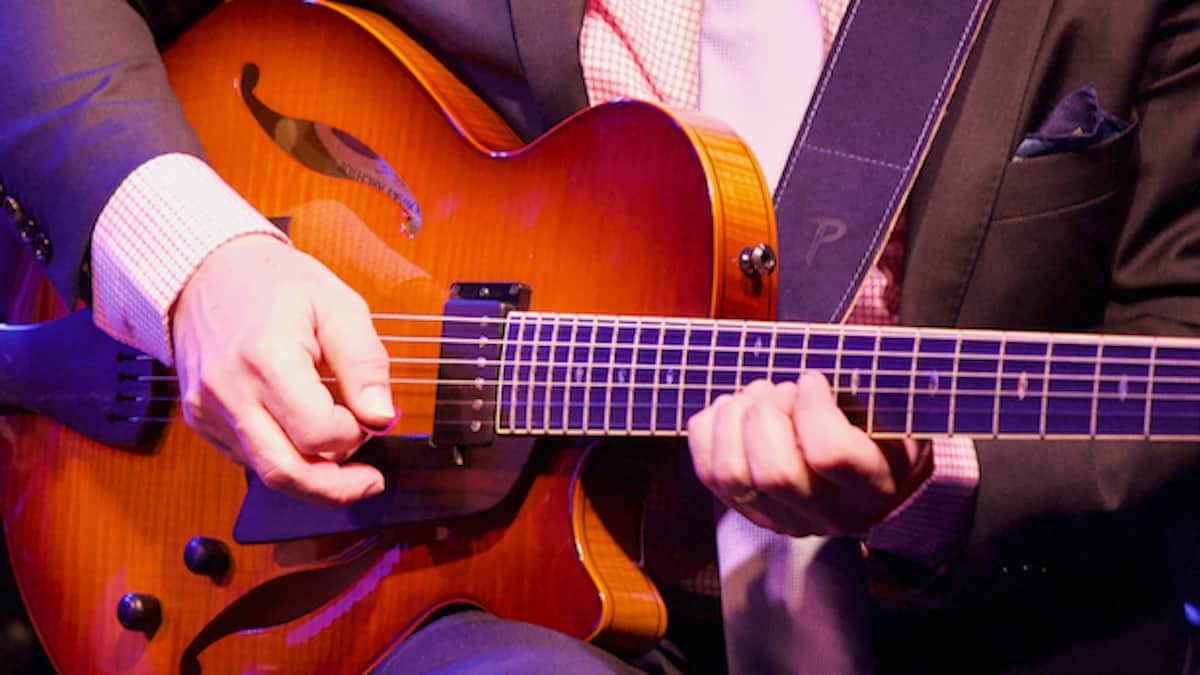Jazz Guitar Lessons
What You Need To Know About Single Note Soloing

In this new lesson, Jazz Guitar Today contributor Vince Lewis shares some of his techniques for single note soloing.
There are a few theories around regarding how to best develop high level single note jazz guitar solos. I have been teaching at the University level for 36 years now, and have tried many approaches with my students. Teaching scale and mode relationships to chords has had decent results with some students. A few years ago I switched my approach from that and my students have really taken off in terms of facility and creativity.
What I now teach is what I call a “target note” system. The first step to this is to learn and master as many extended chord shapes and inversions as possible. I do that by using both straight rhythm charts and chord melody arrangements of standard tunes. Once the student becomes conversant with a lot of locations of chord shapes, then we discuss chord substitutions and movement of various progressions. We then change the standard harmonies and develop new directions of chord movement, and work from there in starting to play improvised single note solos.
The basic principle is that the student plays around the tonality and shape of the chord that is happening in the music. This means keeping a close watch on the music and knowing what chord is being played at all times. Many students try to rely too much on good ears, and forget the importance of always knowing what chord is going on and playing accurately with it.
As the present chord prepares to change to the next one, a target note in that next shape is selected to land on exactly when it falls, and the phrase is either ended or continued from there. What this does is give the player pretty much unlimited options in terms of direction of his or her improvised lines. A single target note can be moved into from above or below. The more inversions of the chord utilized offer many more choices. Add to that the possible substitutions and harmonic reconstruction that is possible, and the player should very seldom have a problem keeping their lines different and fresh.

We start by using slow straight 8th note phrases and hearing how the selected notes match up with the chords. Then we work on more melodic and rhythmic phrases and become more musical and less metronomic in the single note lines. It does not take long for the student to gain confidence that “good” notes will be more and more frequent. This also gives them a terrific start to experimenting with playing a little more outside the standard chord progressions and being more comfortable doing that. Knowing how to get back into the correct tonality and harmony is guaranteed when superior chord knowledge is the base of their experimentation. The shape and target note approach really works far better than anything else I have ever used in my teaching.
This is so much better from my way of thinking than simply matching scales and modes with chords and playing through them somewhat mechanically. I sometimes teach that approach when I have a student who needs a starting point and may not have had the best ear training when they come to my studio. This approach has a definite place for some players, however the “target note” system has been like a miracle in terms of rapid development of excellent improvisational skills.
Hope this helps, and any further info or questions feel free to contact me and I will respond as quickly as I can. Vince Lewis
Subscribe to Jazz Guitar Today – it’s FREE!
-
Jazz Guitar Lessons2 weeks ago
New JGT Guitar Lesson: Analyzing “Without A Song”
-
Jazz Guitar Lessons4 weeks ago
New JGT Guitar Lesson: Considering “Falling Grace”
-
Artist Features1 week ago
New Kurt Rosenwinkel JGT Video Podcast – July 2024
-
Artist Features3 weeks ago
JGT Talks To Seattle’s Michael Eskenazi



















